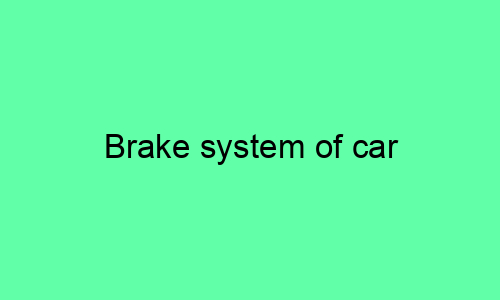Brake System of a Car
The brake system is one of the most important safety features in a car. It allows you to slow down and stop your car in a controlled manner, preventing accidents. The brake system consists of several components, which work together to convert the force you apply to the brake pedal into friction that stops the car.
Components of a Brake System
- Brake pedal: The brake pedal is the lever that you press to activate the brake system. When you press the brake pedal, it pushes against a piston in the master cylinder.
- Master cylinder: The master cylinder is a cylinder filled with brake fluid. When the brake pedal is pressed, the piston in the master cylinder pushes the brake fluid through the brake lines.
- Brake lines: The brake lines are tubes that carry the brake fluid from the master cylinder to the wheels.
- Wheel cylinders: The wheel cylinders are located at each wheel. When brake fluid flows into the wheel cylinder, it pushes a piston that activates the brake pads.
- Brake pads: The brake pads are made of a friction material. When the brake pads are pressed against the brake rotors, they create friction that slows down the car.
- Brake rotors: The brake rotors are discs that are attached to the wheels. The brake pads press against the brake rotors to create friction.
How the Brake System Works
When you press the brake pedal, the force is transmitted through the brake lines to the wheel cylinders. The wheel cylinders activate the brake pads, which press against the brake rotors. The friction between the brake pads and brake rotors slows down the car.
Types of Brake Systems
There are two main types of brake systems: hydraulic brake systems and air brake systems.
- Hydraulic brake systems: Hydraulic brake systems use brake fluid to transmit the force from the brake pedal to the wheels. Hydraulic brake systems are the most common type of brake system used in cars.
- Air brake systems: Air brake systems use compressed air to transmit the force from the brake pedal to the wheels. Air brake systems are typically used in large vehicles, such as trucks and buses.
Maintaining Your Brake System
It is important to maintain your brake system regularly to ensure that it is working properly. Some of the maintenance tasks that you can do yourself include:
- Checking the brake fluid level: The brake fluid level should be checked regularly and topped off as needed.
- Inspecting the brake pads: The brake pads should be inspected regularly for wear and replaced as needed.
- Lubricating the brake caliper slide pins: The brake caliper slide pins should be lubricated regularly to ensure that they are moving freely.
If you are not comfortable performing these maintenance tasks yourself, you should have your car serviced by a qualified mechanic.
Troubleshooting Brake Problems
If you are experiencing any problems with your brake system, it is important to have it checked by a qualified mechanic. Some of the common brake problems include:
- Soft brake pedal: A soft brake pedal can be caused by a number of factors, including low brake fluid, worn brake pads, or a leak in the brake lines.
- Spongy brake pedal: A spongy brake pedal can be caused by air in the brake lines.
- Brake pedal pulsation: Brake pedal pulsation can be caused by warped brake rotors.
- Squealing brakes: Squealing brakes can be caused by worn brake pads.
- Grinding brakes: Grinding brakes can be caused by worn brake pads or rotors.
If you are experiencing any of these brake problems, it is important to have your car serviced by a qualified mechanic as soon as possible.
Conclusion
The brake system is one of the most important safety features in a car. It is important to maintain your brake system regularly and to have it checked by a qualified mechanic if you are experiencing any problems. By following these tips, you can help ensure that your brake system is working properly and that you are driving safely.






